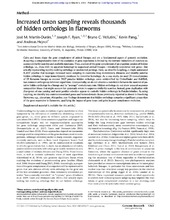| dc.contributor.author | Martin Duran, Jose Maria | |
| dc.contributor.author | Ryan, Joseph Francis | |
| dc.contributor.author | Vellutini, Bruno Cossermelli | |
| dc.contributor.author | Pang, Kevin Scott | |
| dc.contributor.author | Hejnol, Andreas | |
| dc.date.accessioned | 2018-09-06T10:50:05Z | |
| dc.date.available | 2018-09-06T10:50:05Z | |
| dc.date.issued | 2017 | |
| dc.Published | Martin Duran JM, Ryan JF, Vellutini BC, Pang K, Hejnol A. Increased taxon sampling reveals thousands of hidden orthologs in flatworms. Genome Research. 2017;27(7):1263-1272 | eng |
| dc.identifier.issn | 1088-9051 | |
| dc.identifier.issn | 1549-5469 | |
| dc.identifier.uri | https://hdl.handle.net/1956/18413 | |
| dc.description.abstract | Gains and losses shape the gene complement of animal lineages and are a fundamental aspect of genomic evolution. Acquiring a comprehensive view of the evolution of gene repertoires is limited by the intrinsic limitations of common sequence similarity searches and available databases. Thus, a subset of the gene complement of an organism consists of hidden orthologs, i.e., those with no apparent homology to sequenced animal lineages—mistakenly considered new genes—but actually representing rapidly evolving orthologs or undetected paralogs. Here, we describe Leapfrog, a simple automated BLAST pipeline that leverages increased taxon sampling to overcome long evolutionary distances and identify putative hidden orthologs in large transcriptomic databases by transitive homology. As a case study, we used 35 transcriptomes of 29 flatworm lineages to recover 3427 putative hidden orthologs, some unidentified by OrthoFinder and HaMStR, two common orthogroup inference algorithms. Unexpectedly, we do not observe a correlation between the number of putative hidden orthologs in a lineage and its “average” evolutionary rate. Hidden orthologs do not show unusual sequence composition biases that might account for systematic errors in sequence similarity searches. Instead, gene duplication with divergence of one paralog and weak positive selection appear to underlie hidden orthology in Platyhelminthes. By using Leapfrog, we identify key centrosome-related genes and homeodomain classes previously reported as absent in free-living flatworms, e.g., planarians. Altogether, our findings demonstrate that hidden orthologs comprise a significant proportion of the gene repertoire in flatworms, qualifying the impact of gene losses and gains in gene complement evolution. | en_US |
| dc.language.iso | eng | eng |
| dc.publisher | Cold Spring Harbor Laboratory Press | eng |
| dc.rights | Attribution CC BY-NC | eng |
| dc.rights.uri | http://creativecommons.org/licenses/by-nc/4.0/ | eng |
| dc.title | Increased taxon sampling reveals thousands of hidden orthologs in flatworms | eng |
| dc.type | Journal article | eng |
| dc.type | Peer reviewed | eng |
| dc.date.updated | 2018-03-06T08:44:59Z | |
| dc.description.version | publishedVersion | |
| dc.rights.holder | Copyright 2017 The Author(s) | eng |
| dc.identifier.doi | https://doi.org/10.1101/gr.216226.116 | |
| dc.identifier.cristin | 1546255 | |
| dc.source.journal | Genome Research | |

